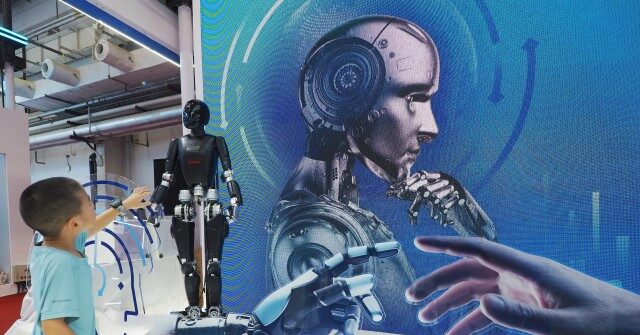The Australian Strategic Policy Institute (ASPI) revealed in a recent report that China has become the world leader in roughly 90 percent of critical technologies and is on track to take the lead in defense technologies as well, including drones and satellites.
ASPI’s latest update to its Critical Technology Tracker reporting project found China “effectively switched places” with the United States as world technology leader in less than twenty years.
“The U.S. led in 60 of 64 technologies in the five years from 2003 to 2007, but in the most recent five years (2019–2023) is leading in seven. China led in just three of 64 technologies in 2003–20074 but is now the lead country in 57 of 64 technologies in 2019–2023, increasing its lead from our rankings last year (2018–2022), where it was leading in 52 technologies,” ASPI found.
“Critical technologies” are a basket of 64 fields covering “defense, space, energy, the environment, artificial intelligence (AI), biotechnology, robotics, cyber, computing, advanced materials and key quantum technology areas.”
ASPI launched the Critical Technology Tracker in March 2023, and recently expanded it to include data stretching all the way back to the turn of the century.
By analyzing data on research papers and technological developments, the tracker determined that China is now leading in quantum sensors, high-performance computing, gravitational sensors, space launch, and advanced integrated circuit design and fabrication. The United States retains a lead in quantum computing, vaccines, nuclear medicine, small satellites, atomic clocks, genetic engineering, and natural language processing.
Most disturbingly, ASPI said China took the lead in every one of the advanced technologies its researchers have classified as “high risk,” meaning a single nation could develop an effective worldwide monopoly on the tech.
“The technologies newly classified as high risk include many with defense applications, such as radar, advanced aircraft engines, drones, swarming and collaborative robots and satellite positioning and navigation,” ASPI added.
The new critical tracker update found that India is also making big strides in critical technology fields. In fact, India has pushed the U.S. out of second place in several fields that are now dominated by China.
On the other hand, the United Kingdom is in straight decline, falling out of the top five nations in eight critical technology fields. Some other tech and industrial powerhouses, including Germany, South Korea, and Japan, have held relatively stable since 2023.
ASPI researchers attributed much of China’s remarkable progress in critical technologies to heavy government financial support and high-performance academic institutions, such as the Chinese Academy of Sciences (CAS).
The authors chided Western democracies for growing complacent with the technological leads they held at the end of the 1990s, and for committing insufficient funding and expertise to cutting-edge research:
Building technological capability requires a sustained investment in, and an accumulation of, scientific knowledge, talent and high-performing institutions that can’t be acquired through only short-term or ad hoc investments.
Reactive policies by new governments and the sugar hit of immediate budget savings must be balanced against the cost of losing the advantage gained from decades of investment and strategic planning.
Among ASPI’s suggestions for rebalancing the technology race was for Western nations to team up with India, Japan, and South Korea to form a more closely integrated technological super-power.
Singapore-based technology strategist Josh Kennedy-White told Voice of America News (VOA) on Tuesday that China benefited from “aggressive, state-driven research and development investments over the past two decades.”
On the other hand, China remains dependent on third parties, including the United States, to produce many of the components it needs for high technology projects. The Chinese Communist government is aware of this vulnerability and wishes to internalize its supply chains, but it has not been able to do so.
“Even though it leads in areas like artificial intelligence and 5G, China still depends on Taiwan, the U.S. and South Korea to produce high-end semiconductors,” Kennedy-White noted, describing China’s lack of self-sufficiency as its “Achilles heel.”
ASPI did not dwell on accusations of Chinese technology theft, but Kennedy-White agreed with complaints from the U.S. and its Five Eyes intelligence partners that much of China’s rapid progress was “not entirely organic.”
“There is a correlation between China’s rise in certain technologies and allegations of intellectual property theft,” he said.

